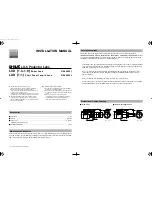
2
Description
The UVA sensor is an ultraviolet light sensor, which primarily responds to UVA
radiation (approx. 320 to 390 nm).
The UVA sensor is built around a broadband UV sensitive silicon photodiode. The
diode produces a current proportional to the UV intensity. A wavelength selective
filter limits light striking the diode to only the UVA region. The signal from the
diode is amplified and sent to the output.
The UVA sensor includes a built-in light diffuser to make the readings somewhat
less sensitive to the orientation of the sensor.
Sensor specifications
The UVA sensor has a memory chip (EEPROM) with information about the sensor.
Through a simple protocol (I
2
C) the sensor transfers its data: name, quantity, unit
and calibration to the interface
1
.
UV radiation
The wavelength region from 320 to 400 nm is commonly called UVA radiation, and
280 to 320 nm is called UVB radiation. Wavelengths shorter than 280 nm fall into
the UVC spectrum. The 0388 and 0389 sensors do not respond to UVC radiation.
Plants and animals respond differently to the three types of UV radiation. Although
very harmful to plants and animals, UVC radiation is nearly completely absorbed by
the ozone in the earth’s atmosphere. Some UVB radiation makes it through the
atmosphere, although the degree of absorption depends critically on the angle of the
sun and the amount of ozone along the light path. UVB radiation is thought to be
responsible for reddening of the skin (erythema), cataracts, and skin cancers. UVA
can also cause these effects on human skin, but to a lesser extent. It is generally
agreed that UVB radiation is the primary danger to humans, but increasingly UVA is
being shown to cause delayed, but significant, damage to skin and eyes.
There are several ways of measuring UV light intensity and exposure. The usual
irradiance unit for measurement is mW/cm
2
, but a simplified UV index system is
also in use. The UV index is actually a forecast, not a measurement. For comparison
with the forecast, some UV sensors can be calibrated in terms of UV index. Since
the UV index includes a wavelength weighting corresponding to the erythemal
action spectrum, only sensors matching the erythemal spectrum can logically be
calibrated in terms of UV index. An erythemally-weighted irradiance measurement
of 0.25 mW/cm
2
corresponds to a UV index of 10.
Since the UV sensors allow the separate measurement of UVA and UVB irradiance
(instead of an erythemally weighted average) the individual readings of the sensors
cannot strictly be converted to UV index units. The erythemal action spectrum is
predominately UVB, however, so an estimate of the UV index can be calculated by
1
This is valid for the following interfaces: CMA
€
Lab
,
BT inputs of CoachLab II/II
+
and
U
LAB,
TI CBL
™
and CBL2
™
, and Vernier LabPro.






















